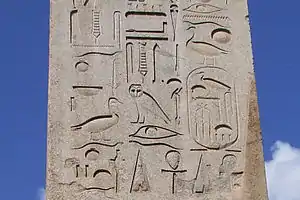
Middle column with story of the obelisk's erection (using mast and obelisk hieroglyph).
| Obelisk in hieroglyphs | ||
|---|---|---|
The ancient Egyptian Obelisk hieroglyph, Gardiner sign listed no. O25 is a portrayal of the obelisk. The hieroglyph is commonly used on erected Egyptian obelisks, as there is often a discussion of the event of its erection: a historical event, as well as an accomplishment of the pharaoh, and the Egyptian Kingdom.
Usage
The obelisk hieroglyph in the Egyptian language is t(kh)n, and is the identical word with the same spelling (different determinatives), for 'to beat a drum', musician, etc. There are other meanings for 'tekhen', as well. The obelisk is a determinative in the Egyptian language, and the word t(kh)n has multiple spellings, since obelisk construction was done over various time periods. Some spellings are:[1]
The second spelling uses the shortened variety of the block-of-stone (hieroglyph),
as the 2nd determinative.
Gallery
See also
Wikimedia Commons has media related to Obelisk (hieroglyph).
References
- Budge, 1978, (1920). An Egyptian Hieroglyphic Dictionary, E.A.Wallace Budge, (Dover Publications), c 1978, (c 1920), Dover edition, 1978. (In two volumes, 1314 pp, and cliv-(154) pp.) (softcover, ISBN 0-486-23615-3)
This article is issued from Wikipedia. The text is licensed under Creative Commons - Attribution - Sharealike. Additional terms may apply for the media files.

